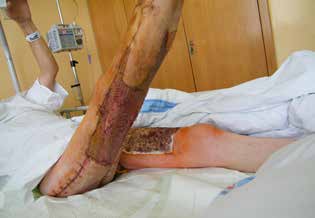Abstract
Necrotizing fasciitis is a dangerous bacterial infectious disease that is not commonplace in Czech society. On the other hand, neither is it so rare
that the majority of surgeons should not come across it occasionally. In the early stages, pathological changes in fascia, subcutaneous tissue and
even skin may run an inconspicuous course. However, this can rapidly deteriorate into shock and sepsis which may lead to multi-organ failure
and an imminent life-threatening condition. The fatality rate of necrotizing fasciitis among high-risk groups (e.g. diabetics, patients who are immuno-
compromised, obese and/or elderly, malnourished, or with a history of drug use), is particularly steep, reaching as high as 73%. Treatment
for this condition consists of early, radical surgical intervention in conjunction with targeted antibiotherapy. Complex resuscitative and intensive
care, including rehabilitation, are standard components of post-surgical management. Use of hyperbaric oxygen therapy, if such an opportunity
exists, is also recommended. Interdisciplinary collaboration is a vital prerequisite for successful treatment. This article describes two case-studies of
necrotizing fasciitis that occurred in men of similar age during a three-year period. Both patients presented with very similar and complicated disease
courses, and both were successfully treated by the same interdisciplinary team comprised of clinicians from various specialized departments.

